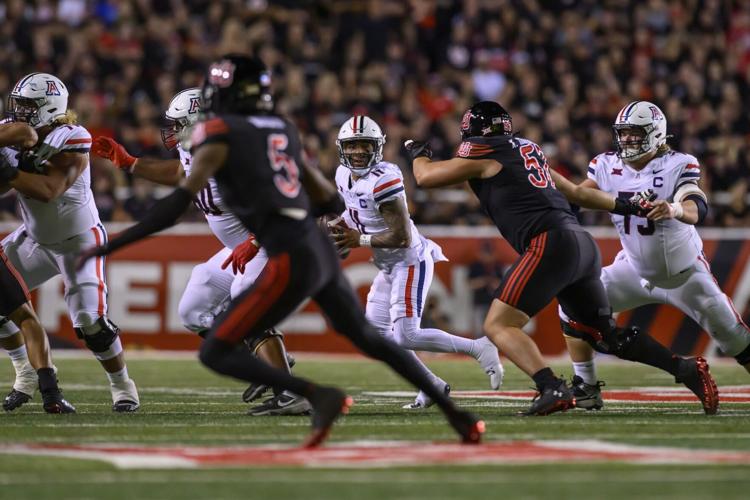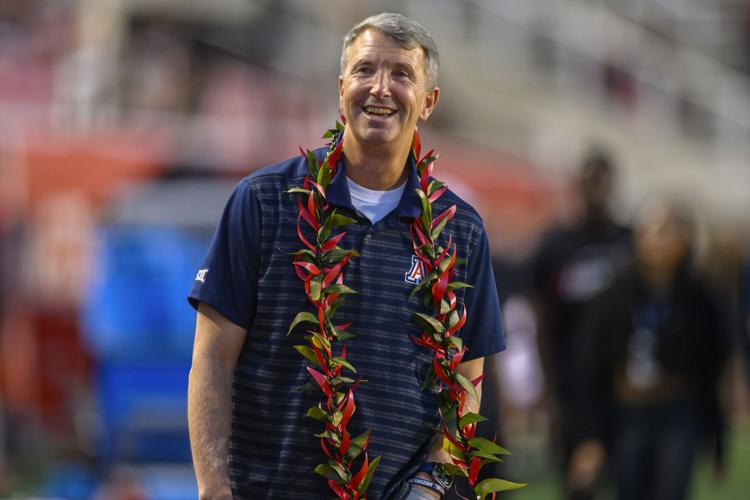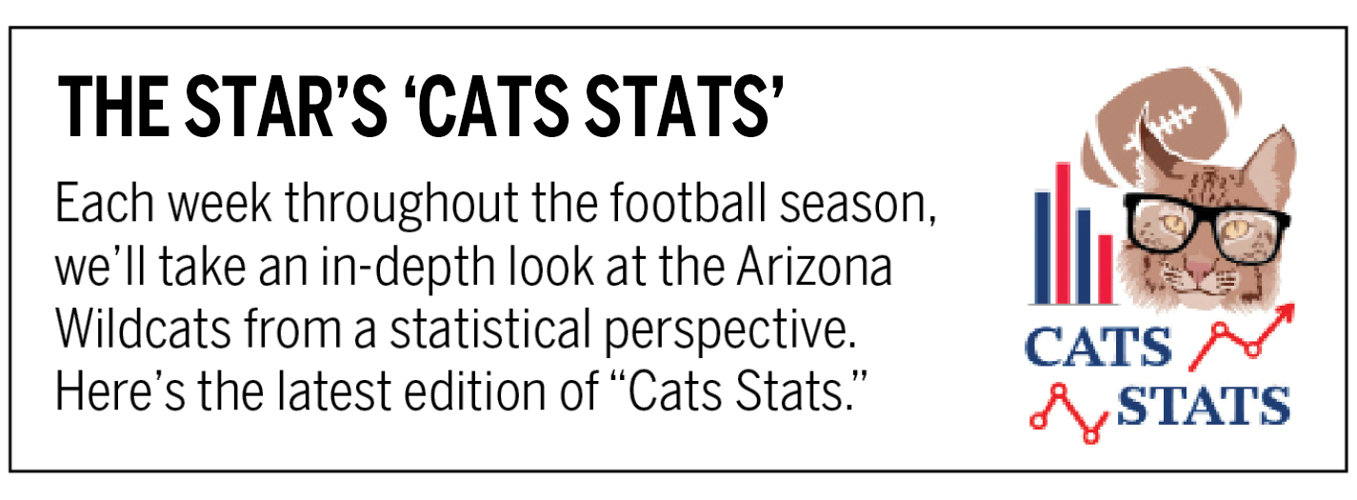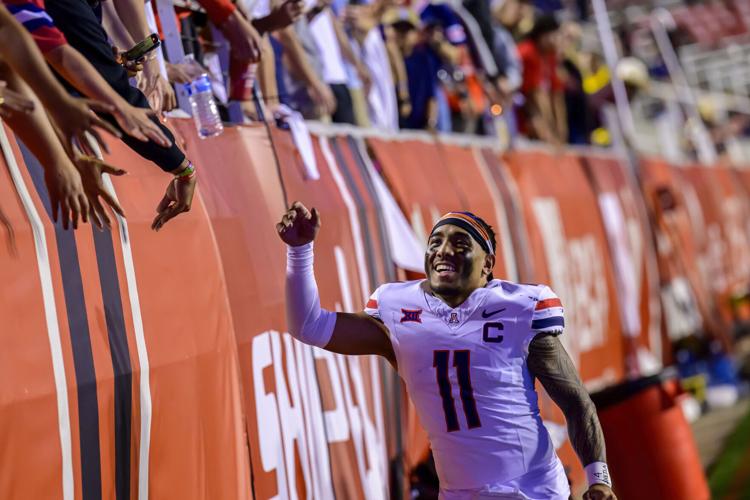Arizona changed its play-calling operation heading into the Utah game, and the initial results were positive. Well, somewhat positive.
The Wildcats upset the 10th-ranked Utes in Salt Lake City after Matt Adkins swapped roles with Dino Babers. Arizona scored 23 points after managing just seven against Kansas State (and only 20 via the offense vs. NAU).

The offense looked different in some ways, including the use of motion and more targets for tight end Keyan Burnett.
But when you dig into the numbers — our ongoing mission at “Cats Stats” headquarters — it largely looks the same.
With a matchup on tap against Texas Tech — the polar opposite of Utah on defense — we’ll examine the state of the UA offense. Where did the Wildcats show promise in Salt Lake City? Where can they still improve?

Arizona wide receiver Tetairoa McMillan (4) celebrates his touchdown against New Mexico with teammates Jeremiah Patterson (2) and Keyan Burnett (88) during the second half of the Wildcats' season-opening victory over the Lobos on Aug. 31 at Arizona Stadium.
What we liked
Burnett’s breakout is a good place to start. The junior caught five passes for 76 yards and a touchdown — all career bests.
We have no way of knowing whether Burnett was the first read on any of those plays. But we do know that he was targeted six times — one more than in either of the previous two seasons. His previous high for a game was three (Oct. 8, 2022, vs. Oregon).
Tetairoa McMillan again had a monster target share at 42.3%, while Burnett was at 23.1%. For the season, McMillan is sitting at 37.6%; four of his teammates, including Burnett, are tied for second at 9.4%.
The more Arizona can spread the ball around, the more effective its offense will be. It’ll also take pressure off McMillan, who’s been visibly frustrated at times during games.
The Wildcats also tweaked their running back rotation, resulting in a more balanced distribution of carries. Quali Conley had 14 rushing attempts to Kedrick Reescano’s seven. In the two previous games, Conley had 31 carries while Reescano had only eight.

Arizona quarterback Noah Fifita celebrates with fans after the Wildcats' 23-10 victory over then-No. 10 Utah on Saturday in Salt Lake City.
Reescano was a force with the ball in his hands vs. Utah, gaining 73 yards and averaging 10.4 yards per attempt. His combination of size and speed and his downhill running style complement Conley’s craftiness well; we wouldn’t mind seeing a 50/50 split moving forward. (In Week 1, when the two main backs were Jacory Croskey-Merritt and Conley, it was closer to that — 13 carries for Croskey-Merritt, 10 for Conley.)
Another encouraging sign: Per Pro Football Focus, QB Noah Fifita’s average time to throw (TTT) dropped to 3.09 seconds after it had been on a steady ascent. That number — which shows how long a quarterback holds the ball before throwing — had gone from 2.69 seconds to 3.25 to 3.44 in Arizona’s first three games. Fifita still has the second-highest TTT in the Big 12 at 3.15 seconds.
Fifita has the second-lowest pressure-to-sack rate (P2S%) at 5.8%, according to PFF. He did not suffer a sack against the Utes despite being pressured 17 times.
Fifita has improved dramatically when it comes to avoiding sacks. His P2S% last year was 17.5%.

Arizona head coach Brent Brennan is all smiles as his team upsets Utah on Saturday in Salt Lake City. The Wildcats improved to 3-1 on the year, and 1-0 in Big 12 play.
What's still concerning
Arizona’s offense has been boom-or-bust this season, and that trend continued at Utah.
The Wildcats converted only 4 of 13 third downs (30.8%), and their average to gain was 8.6 yards. Six of those 13 attempts required 9 or more yards, while only two were of the third-and-short variety (4 yards or less).
“The important part with that is hopefully being more efficient on first and second down so that you're not in those big third-down situations,” UA coach Brent Brennan said, adding that it’s “absolutely critical” to put the offense in better positions.
Arizona has been overly reliant on big plays. The Wildcats had three pass plays of 15-plus yards and six run plays of 10-plus yards vs. the Utes. Those nine plays accounted for 227 yards (25.2 yards per play). The other 52 plays netted just 131 yards (2.5).
The New Mexico and NAU games followed a similar pattern.
Arizona had 17 “big plays” vs. the Lobos for 516 yards (30.4 ypp). The other 40 produced 111 yards (2.8).
The Wildcats had nine big plays vs. the Lumberjacks for 232 yards (25.8 ypp). The other 46 gained just 129 yards (2.8).
Big plays are desirable, of course. But there’s something to be said for positive gains that create manageable conversions.
Four more sets of stats illustrate the all-or-nothing nature of Arizona’s offense:
• Arizona is tied for 85th nationally with 59 plays of 10-plus yards, per CFBStats.com. They’re tied for 47th in plays of 20-plus yards (23), tied for 25th in plays of 30-plus (13), tied for 22nd in plays of 40-plus (seven) and tied for eighth in plays of 50-plus (five). See a trend there?
• The Wildcats ran 61 plays at Utah, tying their season high. They have run 234 offensive plays overall, fewest in the Big 12. They’re 15th in the 16-team league in plays per game at 58.5, just ahead of Houston, which has the worst offense in the conference by any measure.

Arizona quarterback Noah Fifita, center, looks for a receiver during the 23-10 win over then-No. 10 Utah in Salt Lake City on Saturday night. The Wildcats have another tough trip to the Wasatch Mountains coming on Oct. 12 at BYU.
The Cougars average a league-low 4.9 yards per play. The Wildcats, meanwhile, are one of only three teams in the conference to average more than 7 yards per play.
• Arizona had 17 first downs vs. Utah. The Wildcats rank next to last in the Big 12 in first downs per game at 18.3. (Houston is last at 14.2). The 2023 Cats averaged 23.2 first downs per game, third most in the Pac-12.
• Arizona made two trips to the red zone against Utah — consistent with its season average. The Wildcats have had only eight red-zone opportunities this season, again ranking ahead of only the Cougars (seven) in the Big 12.
Arizona averaged 4.4 red-zone trips last season. Texas Tech has a league-high 26, or 5.2 per game, so far this season.
The caveat to all of this is that Utah has one of the best defenses in the Big 12. The Wildcats should be able to move the ball more consistently against the Red Raiders, who don’t.
We’ll be monitoring how Arizona moves the ball Saturday night. Fifita didn’t have a single pass attempt with 10-19 air yards vs. Utah, per PFF. The Wildcats need to make the Red Raiders — and all future opponents — defend all parts of the field. The Cats need to be more incremental, which will make them more efficient.








